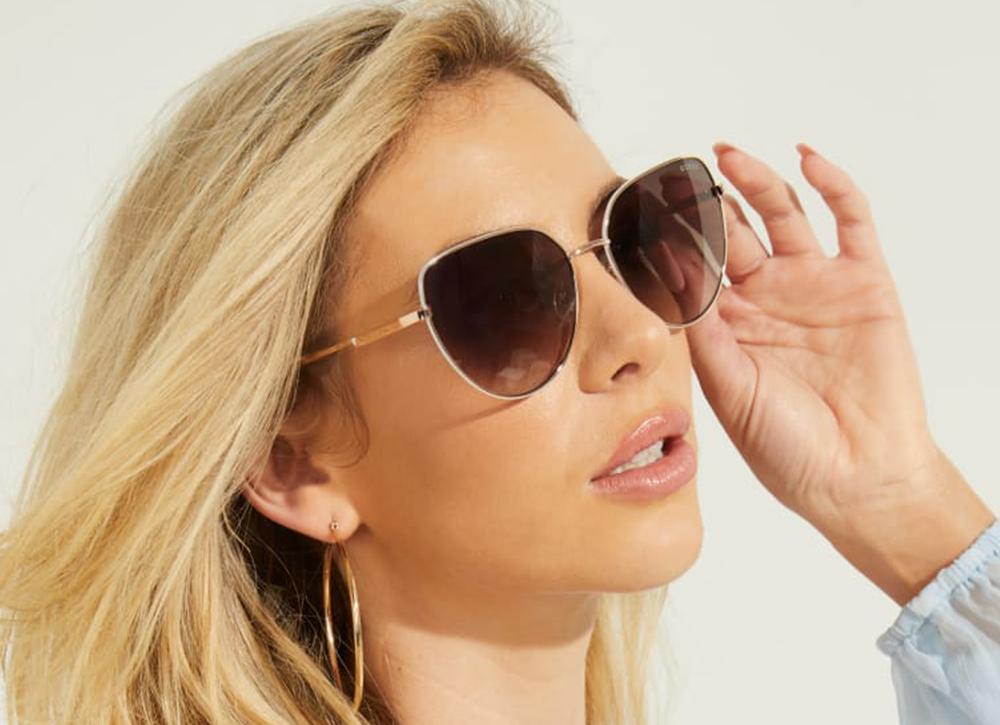What to Consider in Buying Sunglasses: An Extensive Buying Guide
Choosing the right sunglasses involves greater than simply selecting an elegant set. Secret elements include UV protection, lens types, and frame products. Designer Sunglasses For women. Convenience and fit are also crucial for daily wear. Recognizing lens colors and polarization can enhance visual clearness. Furthermore, brand online reputation and service warranty alternatives play a considerable function in making sure a smart investment. Each aspect requires mindful factor to consider to safeguard one's eyes successfully. What should one prioritize initially?
Comprehending UV Protection and Lens Types
When selecting sunglasses, comprehending UV protection and lens kinds is crucial for making sure eye security and comfort. Ultraviolet (UV) rays from the sunlight can trigger significant damages to the eyes, resulting in problems such as cataracts and macular degeneration. Reliable sunglasses must obstruct 100% of UVA and UVB rays, supplying crucial protection.Lens kinds likewise play an essential duty in the functionality of sunglasses. Polarized lenses lower glare from reflective surface areas, making them ideal for tasks like driving or water sporting activities. Slope lenses, which are darker on top and lighter near the bottom, appropriate for general use and exterior activities. Furthermore, photochromic lenses readjust their tint based upon light problems, providing convenience. Ultimately, prioritizing UV defense together with the proper lens type improves both safety and security and visual clearness, permitting individuals to take pleasure in outdoor activities without jeopardizing eye wellness.
Frame Designs and Materials
Selecting the right framework design and material is equally as essential as comprehending UV defense and lens kinds. Different framework designs can considerably affect both aesthetics and capability. Usual designs include aviators, wayfarers, and cat-eye, each accommodating unique preferences and face shapes.Materials made use of in sunglasses frames vary extensively, impacting toughness, weight, and convenience. Plastic frameworks, usually light-weight and budget-friendly, appropriate for informal wear. Steel frames, while typically more resilient, can be heavier but offer a classic appearance. In addition, there are eco-friendly options made from sustainable products, attracting ecologically conscious consumers.The choice of frame product can likewise impact the overall fit and feel of the sunglasses. For those who focus on style or efficiency, understanding the nuances of structure designs and materials guarantees an enlightened acquisition that aligns with individual style and lifestyle needs.
Convenience and Fit Considerations
When selecting sunglasses, the form of the framework plays a vital role in attaining a comfy fit. A correct nose bridge fit is important, as it helps prevent slipping and pain throughout wear. Understanding these factors can significantly enhance the overall experience with sunglasses.
Frame Shape Importance
The form of sunglasses structures plays a necessary role in establishing general comfort and fit. Various framework forms, such as round, square, and pilot, provide to various facial frameworks, influencing just how well the sunglasses remain on the face. A well-matched structure shape can boost stability and minimize pressure factors, making prolonged wear a lot more pleasurable. As an example, rounded frames might soften angular attributes, while square frameworks can include definition to softer face shapes. Additionally, the structure's size ought to straighten with the wearer's face, making sure excellent support. Eventually, choosing the right structure shape is important for balancing style with convenience, as the incorrect choice can cause pain, slippage, or consistent adjustments throughout the day.

Nose Bridge Fit
Commonly overlooked, the fit of the nose bridge is important for making sure convenience and security in sunglasses. A correct nose bridge fit can stop gliding, squeezing, or discomfort during extended wear. Sunglasses commonly come with different nose bridge widths-- narrow, medium, and broad-- to suit varying facial structures. Individuals with higher or lower nose bridges may need certain designs to accomplish optimal fit. Flexible nose pads can additionally boost modification, enabling wearers to modify the suitable for individual comfort. It is very important for purchasers to try out sunglasses to evaluate how they relax on the nose without triggering irritation. Ultimately, the appropriate nose bridge fit adds significantly to the overall performance and pleasure of wearing sunglasses.
Lens Shade and Tints
Lens shade and tints play a vital duty in improving visual convenience and defense from dangerous UV rays. Different tones can impact understanding and contrast, making it necessary to choose ideal alternatives based on specific activities and atmospheres. Comprehending the impacts of various colors can help consumers pick sunglasses that finest fit their requirements.
Different Lens Color Styles
What elements should one take into consideration when choosing lens shades for sunglasses? Various lens colors serve various objectives and can improve aesthetic comfort. Grey lenses lower brightness without misshaping shades, making them optimal for basic use. Brownish and brownish-yellow lenses improve contrast, boosting depth assumption, which is useful for outdoor tasks. Yellow lenses are effective in low-light conditions, giving clarity and raised visibility. Environment-friendly lenses minimize glare while preserving shade balance, ideal for sports and outside enthusiasts. Furthermore, mirrored finishes can better decrease glow and boost design. Personal preference likewise plays a crucial role, as individuals may select shades based upon visual appeal or certain tasks. Recognizing these variables help in choosing one of the most ideal lens shade for one's demands.
Results of Tints

Picking Suitable Tones
How can one determine the very best lens shade and tint for their details requirements? Numerous lens colors and colors offer different objectives, affecting visual comfort and clarity. Gray lenses work for reducing overall brightness while preserving all-natural color balance, making them excellent for day-to-day use. Brown and amber colors improve contrast and deepness perception, appropriate for outdoor tasks like hiking or fishing. Yellow lenses raise visibility in low-light conditions, advantageous for cloudy days. Polarized lenses, no matter of color, reduce glow from reflective surfaces, boosting safety and convenience. It is vital to consider personal tasks and ecological problems when picking lens colors, making sure peak efficiency and defense from hazardous UV rays. Tailoring options to details demands enhances the overall experience with sunglasses.
Polarization and Glare Reduction
Why is polarization essential in sunglasses? Polarization plays a crucial duty in boosting visual convenience and clarity. Sunglasses with polarized lenses are developed to filter out straight light waves, which are largely in charge of glare. This capability greatly minimizes reflections from surface areas such as water, roadways, and snow, making them specifically beneficial for activities like driving, angling, or skiing.Glare can create eye pressure and pain, harming vision and potentially bring about accidents. Polarized lenses enhance comparison and shade assumption, allowing for a clearer view of the surroundings.When thinking about sunglasses, people must seek polarized options to enhance their outdoor experience. While these lenses provide unique benefits, it is necessary to confirm that the sunglasses likewise supply ample UV defense. Together, polarization and UV defense develop a comprehensive solution for keeping eye health and wellness and overall aesthetic comfort in bright problems.
Brand Reputation and Guarantee Options
Many factors add to the choice of sunglasses, brand credibility and warranty options substantially affect consumer choices. Brand names with a solid credibility often suggest top quality and reliability, as they are commonly click over here now established and relied on by customers in time. Buyers frequently incline recognized names that guarantee longevity, style, and security from damaging UV rays.Additionally, service warranty options play a crucial role in the buying choice. A thorough guarantee can supply confidence, covering defects and using fixings or substitutes. This secure urges self-confidence in the item's longevity and performance. Consumers must analyze the size and regards to the service warranty, as well as the brand name's client service reputation, to ensure they are making an educated decision. Inevitably, the mix of brand name track record and warranty choices can notably influence the perceived value and satisfaction derived from a set of sunglasses.
Regularly Asked Concerns
How Do I Clean and Maintain My Sunglasses Properly?

Can I Put On Prescription Glasses With Sunglasses?
Using prescription glasses with sunglasses is feasible with numerous choices, including clip-ons or prescription sunglasses. This pop over to these guys mix guarantees clear vision and defense from UV rays, enabling people to take pleasure in outdoor tasks comfortably and smartly.
Are Expensive Sunglasses Worth the Financial Investment?
The value of pricey sunglasses typically depends on remarkable products, better UV defense, and enhanced toughness. For some individuals, this investment assures long-term eye health and wellness and design, making it worthwhile in spite of the greater initial expense.
What Is the Perfect Lens Width for My Face?
Establishing the perfect lens size entails gauging facial functions. Commonly, wider lenses fit wider faces, while narrower lenses enhance slimmer accounts. Branded Sunglasses for Women. Individual comfort and design choices ultimately guide the selection for best fit and appearance
How Frequently Should I Replace My Sunglasses?
The regularity of sunglasses replacement depends upon usage and wear. Normally, people need to consider replacing them each to 2 years, particularly if lenses are scraped, frameworks are damaged, or UV security decreases gradually.